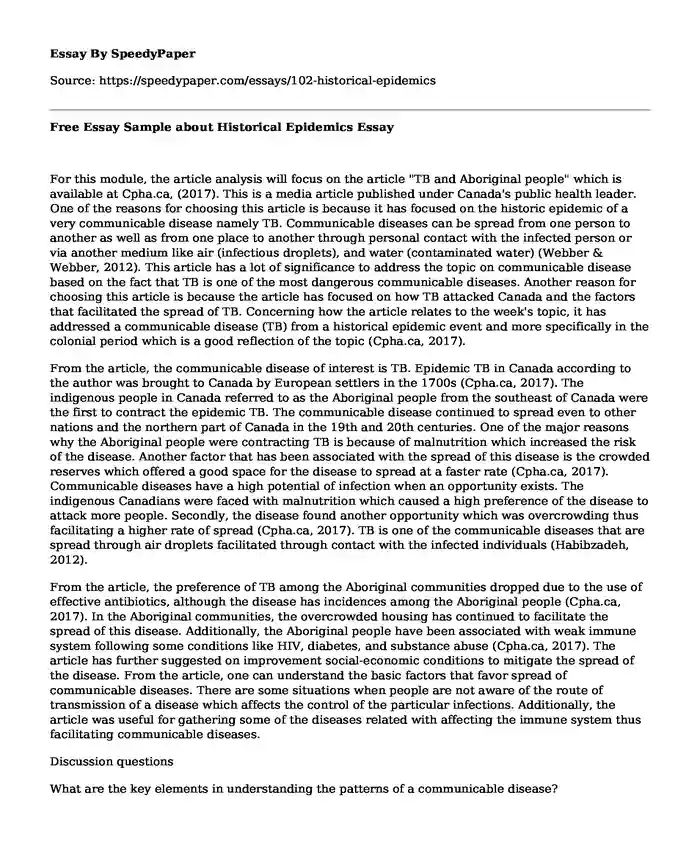For this module, the article analysis will focus on the article "TB and Aboriginal people" which is available at Cpha.ca, (2017). This is a media article published under Canada's public health leader. One of the reasons for choosing this article is because it has focused on the historic epidemic of a very communicable disease namely TB. Communicable diseases can be spread from one person to another as well as from one place to another through personal contact with the infected person or via another medium like air (infectious droplets), and water (contaminated water) (Webber & Webber, 2012). This article has a lot of significance to address the topic on communicable disease based on the fact that TB is one of the most dangerous communicable diseases. Another reason for choosing this article is because the article has focused on how TB attacked Canada and the factors that facilitated the spread of TB. Concerning how the article relates to the week's topic, it has addressed a communicable disease (TB) from a historical epidemic event and more specifically in the colonial period which is a good reflection of the topic (Cpha.ca, 2017).
From the article, the communicable disease of interest is TB. Epidemic TB in Canada according to the author was brought to Canada by European settlers in the 1700s (Cpha.ca, 2017). The indigenous people in Canada referred to as the Aboriginal people from the southeast of Canada were the first to contract the epidemic TB. The communicable disease continued to spread even to other nations and the northern part of Canada in the 19th and 20th centuries. One of the major reasons why the Aboriginal people were contracting TB is because of malnutrition which increased the risk of the disease. Another factor that has been associated with the spread of this disease is the crowded reserves which offered a good space for the disease to spread at a faster rate (Cpha.ca, 2017). Communicable diseases have a high potential of infection when an opportunity exists. The indigenous Canadians were faced with malnutrition which caused a high preference of the disease to attack more people. Secondly, the disease found another opportunity which was overcrowding thus facilitating a higher rate of spread (Cpha.ca, 2017). TB is one of the communicable diseases that are spread through air droplets facilitated through contact with the infected individuals (Habibzadeh, 2012).
From the article, the preference of TB among the Aboriginal communities dropped due to the use of effective antibiotics, although the disease has incidences among the Aboriginal people (Cpha.ca, 2017). In the Aboriginal communities, the overcrowded housing has continued to facilitate the spread of this disease. Additionally, the Aboriginal people have been associated with weak immune system following some conditions like HIV, diabetes, and substance abuse (Cpha.ca, 2017). The article has further suggested on improvement social-economic conditions to mitigate the spread of the disease. From the article, one can understand the basic factors that favor spread of communicable diseases. There are some situations when people are not aware of the route of transmission of a disease which affects the control of the particular infections. Additionally, the article was useful for gathering some of the diseases related with affecting the immune system thus facilitating communicable diseases.
Discussion questions
What are the key elements in understanding the patterns of a communicable disease?
Following the knowledge on communicable diseases, how is the community involved in mitigating the spread of communicable disease?
References
Cpha.ca, (2017). Canadian Public Health Association - TB and Aboriginal People. (2017). Cpha.ca. Retrieved 6 February 2017, from http://www.cpha.ca/en/programs/history/achievements/02-id/tb-aboriginal.aspx
Habibzadeh, F. (January 01, 2012). The control of non-communicable diseases in rural Iran. Lancet (london, England), 379, 9810, 6-7.
Webber, R., & Webber, R. (2012). Communicable diseases: A global perspective. Wallingford, Oxfordshire, UK: CAB International.
Cite this page
Free Essay Sample about Historical Epidemics. (2018, Feb 21). Retrieved from https://speedypaper.net/essays/102-historical-epidemics
Request Removal
If you are the original author of this essay and no longer wish to have it published on the SpeedyPaper website, please click below to request its removal:
- American Foreign Policy Essay Sample
- Free Essay Sample on Value Systems
- Essay Example on the Loss of Culture and Family by Syrians Due to the Civil War
- Essay Sample on "Love Constant beyond Death" written by Francisco de Quevedo
- Critical Essay on Quentin Tarantino's Kill Bill
- Essay Sample on Gender Role Issue
- Essay Sample on Partnership vs S Corporation Taxes
Popular categories





